Great for client-facing tasks, but missing key tools for managing projects end to end
Verdict: 7.5/10
Buildertrend is an all-in-one construction project management platform designed specifically for contractors, remodelers, and specialty construction teams. It’s built to help businesses manage multiple projects at once, streamline client communication, coordinate with subcontractors, and stay on top of budgets and timelines.
Its strength lies in features like change order tracking, scheduling, and budgeting tools—all which are well integrated and surprisingly customizable.
But it’s not without its drawbacks. The learning curve seems steep, especially if you’re not used to construction tech. Buildertrend caters more to large-scale companies, with the company stating it may not be a good fit for businesses with less than $500,000 in construction volume.
Key Features:
- Project scheduling. Use drag-and-drop Gantt charts to build project timelines, assign tasks, set dependencies, and track progress in real time.
- Budgeting & cost tracking. Create job budgets, manage purchase orders and change orders, and compare actual costs against estimates.
- Proposals & invoicing. Build proposals, turn them into invoices, and collect digital signatures—all in one system.
- Daily logs. Record daily jobsite activity, including weather, photos, worker hours, notes, and delays.
- Document & file management. Upload and store blueprints, permits, contracts, and images. Files are accessible to the right team members through mobile or web.
- Client communication tools. Give clients a branded portal where they can log in, review updates, approve changes, and stay informed about progress.
- Team messaging & notifications. Let field and office teams stay in touch with built-in messaging. Set up automated notifications for task deadlines, approvals, and more
- Time tracking & timesheets. Enable employees to clock in/out via mobile, with GPS stamping and activity logging. Review timesheets or export them directly to integrated payroll systems.
- Reporting & analytics. Generate job cost reports, labor hour summaries, and progress reports to monitor performance and flag risks early.
Pros
- All-in-one construction management platform
- Intuitive mobile app for field teams
- Built-in client portal for transparency and communication
- Responsive customer support
Cons
- No free trial
- Not suited to smaller businesses earning under $500,000
- No shift scheduling
- Steeper learning curve for new users
Buildertrend Pricing
Buildertrend uses a custom pricing model, offering tailored quotes based on your company’s size, annual construction volume, and specific operational needs.
When I contacted Buildertrend’s sales team directly, I was told that most customers pay between $8,000 and $10,000 per year. This cost includes access to all platform features and unlimited users under a single company license.
This pricing structure makes it a solid fit for growing construction firms that don’t want to deal with per-user pricing as their team scales.
To get a quote, you must fill out a short form on Buildertrend’s website. When I selected the $0–$499,000 annual construction volume option during testing, the system responded that Buildertrend may not be the best fit for smaller businesses.
That response aligns with the platform’s broader positioning: Buildertrend is designed for mid-sized to large construction businesses running multiple projects at once and requiring advanced scheduling, client communication, and financial tools.
One notable downside is the lack of a free plan or trial. While some competitors offer time-limited access or feature-limited free tiers, Buildertrend offers neither. You must schedule a demo just to explore the software. Given the potential investment involved, many prospective users may prefer to try the software in a real-world setting before making a decision. And there are construction management tools—like BuildXact, Raken, and Connecteam—that offer free trials (Connecteam even offers a free plan).
Absolutely free, no credit card required
Start your free trialOverall, while Buildertrend’s pricing seems reasonable for larger companies with complex needs, it’s not suitable for smaller operations or those that want to evaluate the tool in depth before committing financially.
Also, many user reviews—like those on Capterra—complain about high costs.
Here’s some pricing information for similar software:
| Team size | Buildertrend | BuildXact (Pro) | Raken (Performance) | Connecteam (Expert) |
|---|---|---|---|---|
| View pricing | View pricing | View pricing | View pricing | |
| 10 Users | Custom pricing** | $1226 | Custom pricing | Free for life — All features and dashboards |
| 20 Users | Custom pricing** | $2096 | Custom pricing | $99 |
| 30 Users | Custom pricing** | $2866 | Custom pricing | $99 |
| 50 Users | Custom pricing** | $4706 | Custom pricing | $159 |
| Read our full review | Read our full review | Learn more about Connecteam | ||
| *All prices show the monthly cost when billed annually as of June 2025. **Buildertrend may not take on customers with this few users—the company typically works only with medium to large businesses. | ||||
Verdict: 4/10
Buildertrend Usability and Interface
I scheduled a demo with Buildertrend, but unfortunately, the meetings were canceled, and I never received a follow-up to reschedule. The support team did follow up with some helpful resources and videos, which gave me a good sense of how the platform works in practice. I also looked at user reviews.
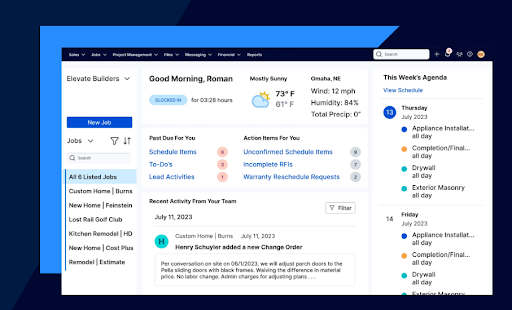
From what I observed, Buildertrend’s interface is modern, clean, and built with construction professionals in mind. It includes highly specialized features—like scheduling, budgeting, change orders, purchase orders, and client communication tools—that are logically arranged within the dashboard.
However, this depth also makes the platform feel a bit overwhelming at first glance. It’s clearly designed for users already familiar with construction management workflows, so beginners may need formal onboarding to feel comfortable navigating the system.
The overall layout is intuitive once you know where to look, with well-labeled menus and minimal visual clutter. Still, Buildertrend doesn’t appear to offer much user guidance within the interface itself.
The text is legible and color contrast seems sufficient, but it’s unclear whether Buildertrend supports assistive technologies like screen readers or keyboard-only navigation—features that matter for an inclusive user experience.
Verdict: 8/10
Mobile app
Buildertrend’s mobile app is built for teams in the field, offering streamlined access to the platform’s most essential tools. From the summary screen, users can quickly check key updates across all projects or drill into individual jobs. Core features like Daily Logs, Time Clock, and To-Do’s allow site crews to document progress, track hours, and manage punch-list items directly from job sites.

As far as I could tell, all essential features are available on both the web and mobile versions of Buildertrend. The Schedule tool, for example, is fully accessible and editable via the app, making it easy for teams to adjust timelines on the go. Users can also upload photos, documents, and videos directly from their mobile device, which is ideal for capturing real-time updates on-site.
| Feature | Website | Mobile App |
| Core features | ||
| Summary screen | ✅ | ✅ |
| Client portal | ✅ | ✅ |
| Daily logs | ✅ | ✅ |
| Time clock | ✅ | ✅ |
| File view/uploads | ✅ | ✅ |
| To do’s | ✅ | ✅ |
| Project scheduling | ✅ | ✅ |
| Schedule templates | ✅ | ✅ |
| Customer portal | ✅ | ✅ |
| Offline access | ✅ | ✅ |
| Finance and analysis | ||
| Cost estimation | ✅ | ✅ |
| Reporting and analytics | ✅ | ✅ |
| Buildertrend payments | ✅ | ✅ |
| Bid proposals and estimates | ✅ | ✅ |
| Bills and purchase orders | ✅ | ✅ |
| Communication features | ||
| Internal inbox | ✅ | ✅ |
| Job comments | ✅ | ✅ |
| Request For Information (RFI) | ✅ | ✅ |
| Customer portal | ✅ | ✅ |
| Subcontractor portal | ✅ | ✅ |
| Change orders | ✅ | ✅ |
Verdict: 8/10
Buildertrend Core Functionalities
Scheduling and task management
From what I could see, Buildertrend’s scheduling tools are built specifically for construction professionals—especially home builders and remodelers—offering far more than just a digital calendar. I like how you can set both projected and actual start and end dates for each job, along with designated workdays to create accurate timelines and track progress in real time.
Schedules are highly customizable, with multiple view options depending on your role or preference. You can switch between a Gantt chart for task dependencies, a calendar or agenda view for day-to-day planning, or a baseline view to compare planned vs. actual progress. I think this flexibility makes it easier to communicate project timelines with both internal teams and clients.
I appreciate how you can break tasks into multi-tiered work activities, assign total workdays, and organize tasks by color or category. For example, you might color-code all plumbing-related work or group tasks by subcontractor to keep things clear and organized.
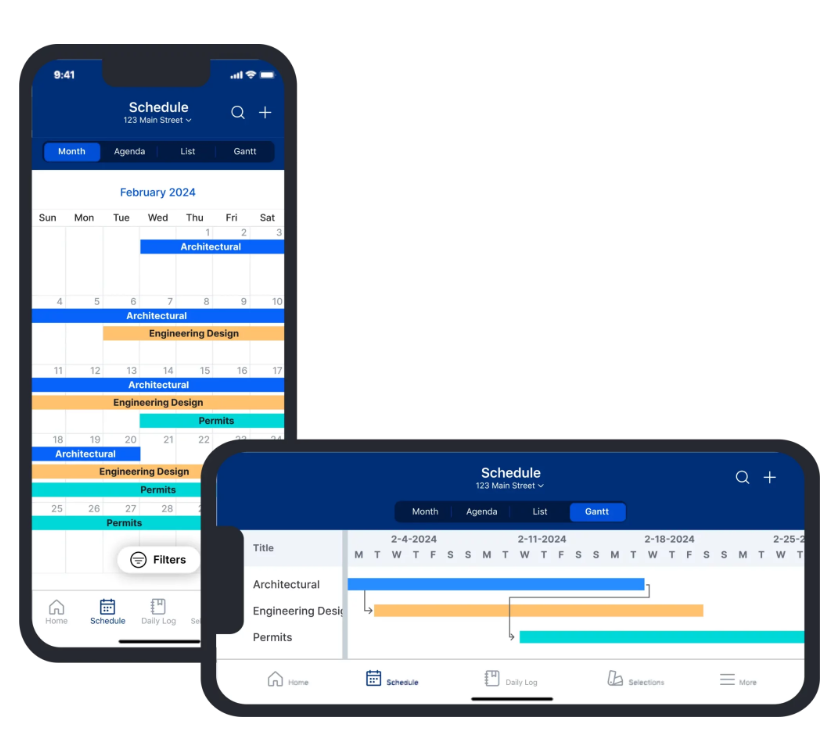
Buildertrend also lets you link tasks in a “waterfall” format, meaning one task can’t begin until the previous one is marked complete. This adds structure to the schedule, and I believe it could prevent teams from working out of sequence.
For recurring job types, you can build and save schedule templates. These are great for streamlining timelines across similar projects and keeping your planning consistent from job to job.
Unfortunately, the scheduling tools lean more toward project-level coordination than individual shift planning. If you’re looking to schedule hourly staff or manage last-minute shift swaps, you’ll need to use a separate tool alongside Buildertrend—or an alternative. Some alternative platforms, like Connecteam, offer job and task scheduling and shift planning.
Verdict: 8/10
Client Portal
From what I’ve seen in Buildertrend’s documentation and user feedback, the platform gives clients easy access to their projects through a simple, user-friendly portal. Clients can log in to check updates, make selections, review change orders, and message their builder directly. I appreciate that everything is centralized—it helps reduce back-and-forth emails and keeps everyone aligned.
I also like how Buildertrend automatically generates AI-powered weekly updates. These summaries pull from existing project data to show recent progress and upcoming tasks. Builders don’t need to manually compile these reports—which saves time while keeping clients informed.
The portal also lets clients view daily logs, browse shared photos, and communicate in real time. I like that they can ask questions or leave comments and get responses all in one place. It creates a consistent communication flow and builds a clear record of decisions and conversations.
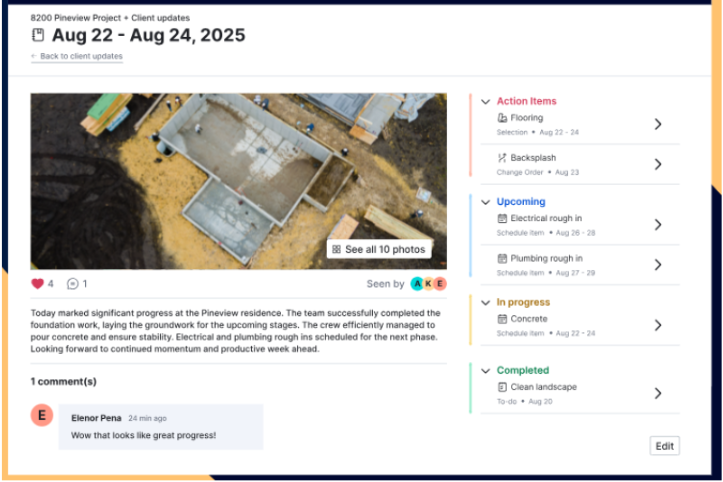
Buildertrend also supports selections, invoicing, and payments through the same portal. This kind of all-in-one access is a big time-saver—especially for builders managing multiple clients or projects, and for clients wanting to stay updated.
Verdict: 10/10
Financial Management
Buildertrend’s financial tools look well-suited to help construction businesses stay organized, accurate, and profitable by streamlining essential tasks like bidding and purchase order (PO) management.
I like how the bidding software keeps all bid activity in one place. Having a single source of truth for each project makes it easier to stay on top of everything. You can send bid packages to multiple subcontractors at once, which saves time and ensures everyone gets the correct specs to quote accurately.
Automated reminders and deadlines help move things along, and bid data syncs with other Buildertrend tools like estimating and job costing—so you don’t have to re-enter anything. I think this kind of integration could help you turn around estimates faster and improve your chances of winning jobs.
With Buildertrend’s purchase order features, you can set and manage spend limits per project, which supports more accurate budgeting. This makes it easier to control costs, plan cash flow, and reduce the risk of disputes over payments.

POs are centralized and digitally tracked, making it easy to see which orders are pending, approved, or paid. This improves forecasting, speeds up procurement, and ensures materials and subcontractors arrive on time. It also eliminates manual paperwork by storing digital approvals and syncing data directly with job costing—giving you a clear picture of profitability while reducing admin burden and risk of error.
That said, some users have noted that the functionality isn’t as sophisticated as other popular financial management products.
Verdict: 8/10
Time tracking and timesheets
Buildertrend’s time tracking tools are purpose-built for construction sites. Workers can clock in and out directly through the mobile app—even when offline—ensuring accurate records regardless of site connectivity. I appreciate how the app stores entries locally and syncs them once a connection is restored.
I also like how geofencing adds another layer of reliability by automatically logging workers’ attendance and work hours based on their GPS locations, helping to verify that employees are on-site during their contracted hours. Crew leaders can also manage entries for their teams, and all time data can be assigned by job or cost code for more accurate project billing and labor tracking.

Time and attendance data can be synced directly with payroll systems, reducing manual entry and minimizing errors. Buildertrend also integrates with popular HR platforms, streamlining the entire payroll process. Regular labor reports give you visibility into productivity and resource allocation, helping teams make data-driven decisions about scheduling and workforce management.
While these tools are comprehensive for fieldwork, from what I can see, they lack shift planning or automated alerts for managing breaks or overtime. I wish the time clock worked more like Connecteam’s: It comes with break reminders, break automation, overtime alerts, and so much more.
Verdict: 8/10
Document and file sharing
Buildertrend’s document management tools are designed to eliminate paper clutter and keep construction teams organized. I appreciate how everything—from blueprints to signed contracts—is stored in clearly labeled, job-specific folders that are easy to access from both desktop and mobile devices.
I like how you can upload photos, videos, and files directly from the field, and simplify approvals by allowing clients to sign contracts right from their phones—no in-person meetings required.
The system also supports permission-based sharing, so you can control who sees what, ensuring sensitive information stays secure while keeping teams and subcontractors aligned.
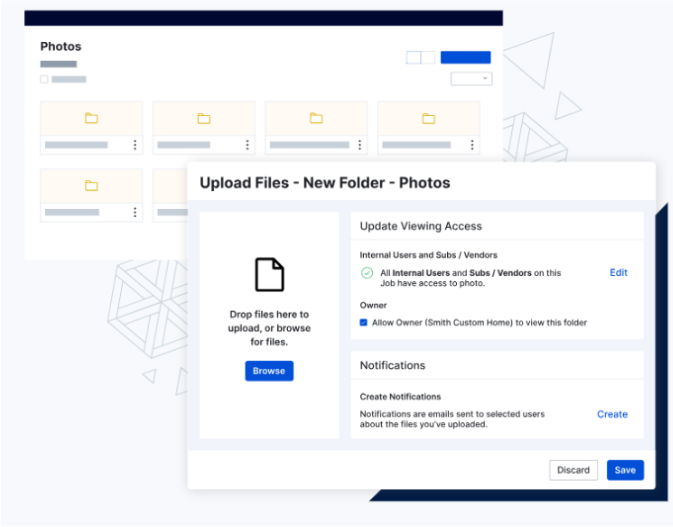
Buildertrend helps teams stay on the same page by ensuring everyone works from the most up-to-date file version. Older versions remain accessible for reference. I think this is especially useful for project plans and takeoff documents that frequently change. Subs and crews can pull these files on-site from their phones, reducing delays and miscommunication.
All signed contracts are securely stored, creating an easy audit trail in case of disputes or legal questions. Visual documentation—like job site photos or videos—is also neatly organized, providing quick access to proof of work, especially useful for warranty claims.
Verdict: 10/10
Buildertrend Security Features
Buildertrend uses several standard security measures to protect user data, though I think there’s room for improvement in some areas.
- Data encryption and firewalls are in place to protect information during transfer and storage.
- Two-factor authentication (2FA) is available but must be enabled manually by each user, which can leave accounts vulnerable if not configured.
- Idle sessions aren’t automatically logged out, posing risks if devices are left unattended on job sites or shared workstations.
- Buildertrend offers HIPAA compliance for high-tier users and adheres to general data privacy standards.
- The platform is hosted across 2 geographically separate data centers, with real-time replication and regular backups to support disaster recovery.
- Buildertrend operates on an SQL database, and file data is routinely backed up and synced with a recovery center.
- There are no biometric login options, such as fingerprint scanning.
- User roles and permissions are available but lack the depth of advanced role-based access controls.
Verdict: 7/10
Buildertrend Reporting & Analytics
Buildertrend offers a strong suite of reporting tools designed for construction project management and financial tracking. While it falls short in employee-specific reporting—such as attendance or time tracking—it shines when it comes to customizable, project-based analytics.
Buildertrend includes reports on project timelines, task progress, budget tracking, cost breakdowns, and overall job performance. Users can use industry-standard templates or build custom dashboards to suit their needs.
Reports are automatically generated from your project data and can be customized with filters, graphs, and formatting options. Exporting is simple, and the interface is intuitive for most users. For more advanced needs, Buildertrend provides data consulting to help create tailored reports.
The platform visualizes raw data clearly but doesn’t offer true AI-powered analytics. What Buildertrend labels as “AI” is more accurately semi-automated data sorting and formatting. It lacks predictive insights or automated recommendations.
Overall, Buildertrend’s reporting features are flexible and visually helpful for tracking project health and finances. However, professionals looking for deeper, AI-driven insights may find its analytics more basic.

Verdict: 7/10
Buildertrend Customer Support
Buildertrend offers multiple customer support channels to assist users, though the quality and speed of service can vary slightly depending on the method used.
- Types of support: Phone, email, live chat, and an in-depth online knowledge base.
- Availability: Phone support is available Monday–Friday, 7 a.m.–5 p.m. Central Time.
- Helpfulness: Most users report positive experiences with Buildertrend’s support team, highlighting knowledgeable and friendly representatives.
- Response time: Live chat is typically quick, with responses arriving within minutes. When I contacted support via email, the first response came within a few hours, but follow-up communication took a few days, which disappointed me.
- Sales support: Demo scheduling was quick and initially for me, but after my meeting was cancelled, no one followed up to reschedule, which was disappointing.
Verdict: 6/10
What are Buildertrend Review Ratings from Review Sites?
(As of June 2025)
Capterra: 4.5/5
G2: 4.2/5
Software Advice: 4.5/5
TrustRadius: 7.6/10
GetApp: 4.6/5
Google Play Store: 4.2/5
Apple App Store: 4.5/5
Buildertrend App Review
Buildertrend is ideal for mid-sized to large construction businesses seeking comprehensive scheduling, financial, and client communication tools all in one platform. Its strengths lie in streamlining project workflows and keeping clients informed.
However, smaller businesses or those needing advanced AI-driven analytics or more flexible free trials might find it limiting. Users prioritizing highly comprehensive security or extensive employee time tracking or shift scheduling features should consider alternative solutions.
Connecteam: The Better Buildertrend Alternative
If you’re looking for an alternative to Buildertrend, I think Connecteam’s construction app is worth a closer look. While Buildertrend does a great job with project management—especially with features like scheduling, budgeting, and job costing—I like that Connecteam focuses more on simplifying day-to-day field operations. It brings together time tracking, task management, communication, and reporting into one easy-to-use platform.
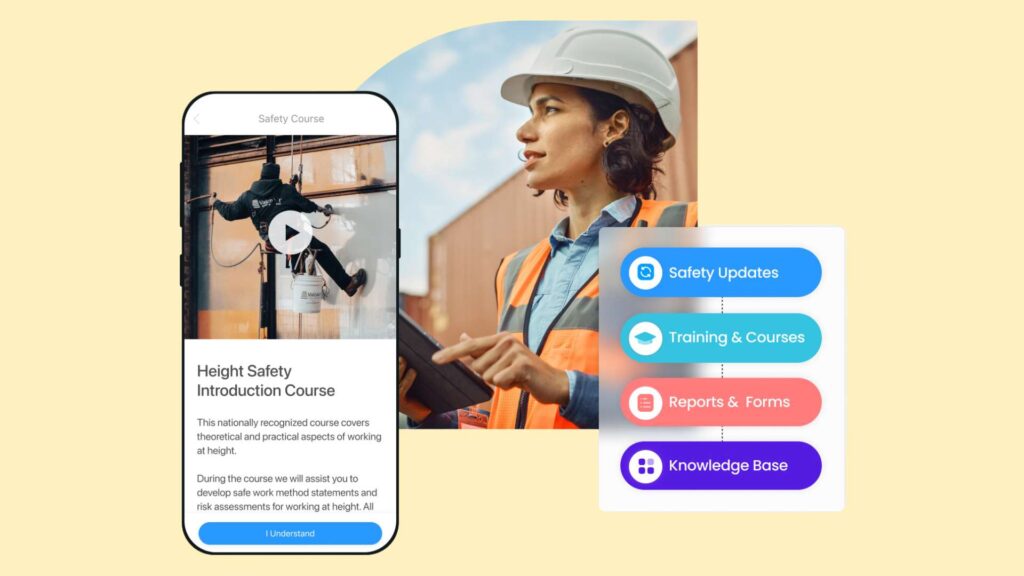
I’ve found Connecteam extremely intuitive. Its mobile-first design makes it easy for crews to use on the go, and the GPS-enabled time tracking clock with geofencing is great for knowing exactly who’s on-site and when. The drag-and-drop employee scheduler is another feature I like—it makes workforce planning a lot more efficient.
One area where I think Connecteam stands out is internal communication. Unlike Buildertrend, it includes built-in chat, announcements, surveys, and even an employee directory. These tools make it easier to keep everyone aligned without relying on separate apps or long message chains.
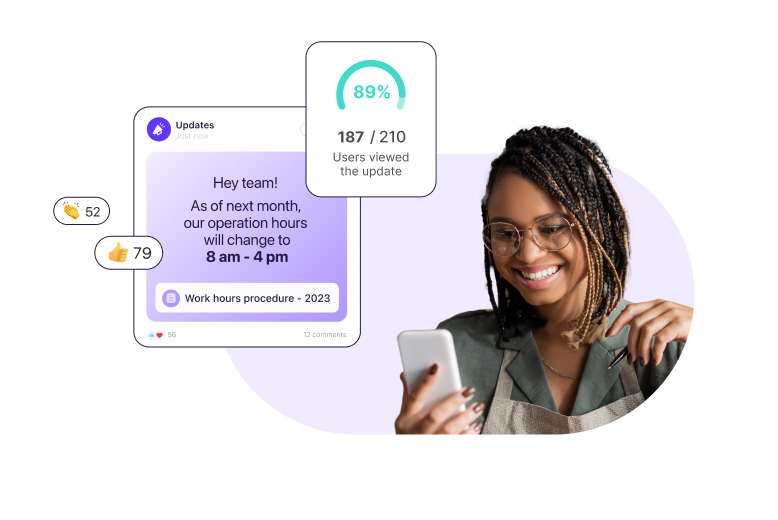
What really sets Connecteam apart for me is how much it can do beyond just managing projects. You can create digital forms and checklists, assign and track tasks, deliver on-site training, and even automate routine workflows—all tailored to construction workflows.
I also appreciate the added security features. Connecteam offers biometric logins, auto-logout, and detailed user permissions, which help protect sensitive project data and make sure the right team members have the right access.
In short, Connecteam delivers a more comprehensive workforce management solution that goes well beyond scheduling and job tracking—plus, it’s extremely affordable and offers a free trial and free plan for small businesses.
FAQs
Buildertrend doesn’t offer a free trial. Instead, prospective users can schedule a demo to explore the platform’s features before committing to a subscription.
Buildertrend isn’t inherently HIPAA-compliant. However, it offers HIPAA-compliant features for high-tier users upon request.
